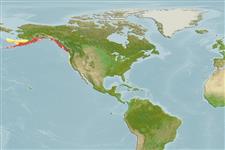Environment: milieu / climate zone / depth range / distribution range
Ekologi
marina bottenlevande; djupintervall 6 - 128 m (Ref. 12204). Temperate; 60°N - 38°N, 175°W - 120°W
Northeast Pacific: southeast Bering Sea to northern California, USA.
Size / Vikt / Age
Maturity: Lm ? range ? - ? cm
Max length : 117 cm TL hane/ej könsbestämd; (Ref. 12204)
Short description
Bestämningsnycklar | Morfologi | Morfometri
Taggstrålar i ryggfenan (totalt) : 72 - 77; Mjukstrålar i ryggfenan (totalt) : 0; Taggstrålar i analfenan: 2; Mjukstrålar i analfenan: 43 - 49. Pale brown in color, with touches of yellow or violet (Ref. 12204).
Found on soft bottoms (Ref. 12204). Probably spends part of its life buried (Ref. 12204).
Life cycle and mating behavior
Könsmognad | Reproduktion | Lek | Ägg | Fecundity | Larver
Coad, B.W., 1995. Encyclopedia of Canadian fishes. Canadian Museum of Nature and Canadian Sportfishing Productions Inc. Singapore. (Ref. 12204)
IUCN Red List Status (Ref. 130435: Version 2024-1)
Threat to humans
Harmless
Human uses
Verktyg
Special reports
Download XML
Internet-källor
Estimates based on models
Preferred temperature (Ref.
123201): 4.1 - 10.1, mean 6.8 °C (based on 180 cells).
Phylogenetic diversity index (Ref.
82804): PD
50 = 0.6250 [Uniqueness, from 0.5 = low to 2.0 = high].
Bayesian length-weight: a=0.00389 (0.00180 - 0.00842), b=3.12 (2.94 - 3.30), in cm total length, based on all LWR estimates for this body shape (Ref.
93245).
Trofisk nivå (Ref.
69278): 3.1 ±0.1 se; based on size and trophs of closest relatives
Fishing Vulnerability (Ref.
59153): High to very high vulnerability (70 of 100).
